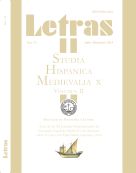Please use this identifier to cite or link to this item:
https://repositorio.uca.edu.ar/handle/123456789/3783| Título: | El libro de Alexandre : un repositorio de saber geográfico | Autor: | Fernández Izaguirre, Penélope Marcela | Palabras clave: | LITERATURA ESPAÑOLA; LITERATURA MEDIEVAL; LITERATURA DE VIAJES; GEOGRAFIA; MANUSCRITOS | Fecha de publicación: | 2015 | Editorial: | Universidad Católica Argentina. Facultad de Filosofía y Letras | Cita: | Fernández Izaguirre, Penélope Marcela. “El Libro de Alexandre : un repositorio de saber geográfico” [en línea]. Letras, 72 (2015). Disponible en: https://repositorio.uca.edu.ar/handle/123456789/3783 | Resumen: | Resumen: El viaje como tema literario es muy recurrente en los textos del Medioevo, uno de ellos es el Libro de Alexandre que presenta a su personaje principal, Alejandro Magno, como protagonista de múltiples periplos por lugares desconocidos y asombrosos. Si bien las cuadernas dedicadas a los recorridos del macedonio permiten a los receptores del texto integrarse al mundo de lo maravilloso medieval, por el otro lado, estas no se limitan solo al cuidado del aspecto narrativo, pues algunas de ellas también encierran la mejor muestra de la sapiencia enciclopédica en el rubro de la geografía. Por lo tanto, en esta comunicación analizaré algunos de los episodios que nos lleven a identificar al Libro de Alexandre como un verdadero repositorio del saber geográfico vigente en la Edad Media. Para lo anterior me remitiré a tres escenas del libro hispánico medieval en cuestión: 1) descripción general del mundo (cc. 276-281) y elogio de Asia (cc. 282-294), 2) división de la tierra, los continentes y su forma (cc. 2509-2513) y 3) mapamundi de la tienda de campaña (cc. 2576-2585). Con lo anterior, se demostrará que lejos de dañar la funcionalidad comunicativa, recapitular el caudal de información sobre el globo terráqueo favorece la revisión de los conocimientos de la Geografía Antigua, aún vigentes en la Edad Media. Finalmente, se hará énfasis en la estrategia discursiva que suministra el conocimiento a través de las fuentes enciclopédicas; el pensamiento científico como patrón de lo verificable y, por último, la formulación y evidencia creíble de los contenidos con la representación gráfica del mundo. Abstract: The voyage as a literary topic is very recurrent in medieval texts. One of them is the Libro de Alexandre, which introduces its main character, Alexander the Great, as a protagonist of multiple journeys around unknown and astonishing sites; furthermore, the stanzas dedicated to the Macedonian’s travels allow the text receivers (readers) to participate in medieval amazement; on the other hand, not only do these aspects concern the narrative structure but they also convey the best sample of encyclopedic wisdom in the field of geography. Therefore, in this paper I will analyze some chapters of the Libro de Alexandre that prove to be a truly repository of the geographical knowledge of the Middle Ages. I intend to focus on three scenes from the medieval hispanic book: 1) the world’s general description (cc. 216-281), 2) the earth’s division, the continents and their shape (cc. 2509-2513) and Asia’s praise (cc. 288-294), and 3) the mapamundi in the tent (cc. 2576-2585). The former will show that far from diminishing the communicative functionality, the recapitulation of information concerning the terrestrial globe favors the review of ancient geography, still prevailing in the Middle Ages. Finally, I will put emphasis on the discursive strategy that provides knowledge through encyclopedic sources; scientific thought as a credible model of the verifiable; and the formulation and evidence provided by the graphic representation of the mapamundi. |
URI: | https://repositorio.uca.edu.ar/handle/123456789/3783 | ISSN: | 0326-3363 | Disciplina: | LITERATURA | Derechos: | Acceso Abierto | Fuente: | Letras Nº 72, 2015 |
| Appears in Collections: | LETRAS - 2015 nro. 72 |
Files in This Item:
| File | Description | Size | Format | |
|---|---|---|---|---|
| libro-alexandre-saber-geografico.pdf | 184,2 kB | Adobe PDF |  View/Open |
Page view(s)
315
checked on Apr 30, 2024
Download(s)
353
checked on Apr 30, 2024
Google ScholarTM
Check
This item is licensed under a Creative Commons License

